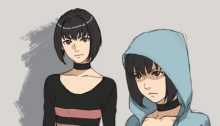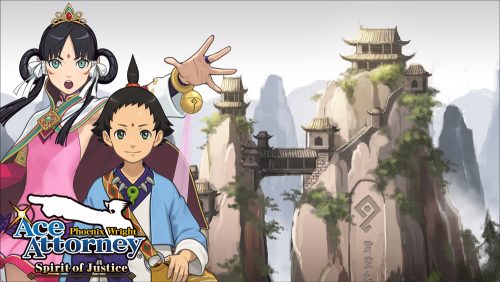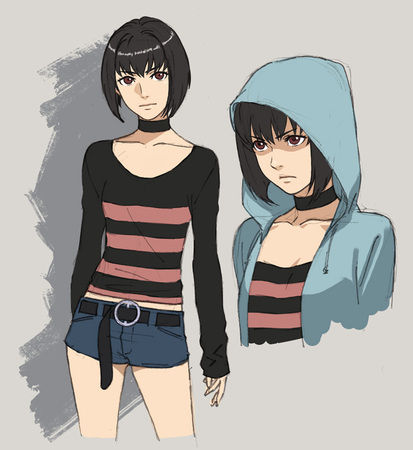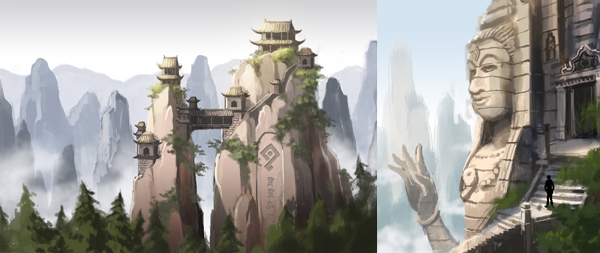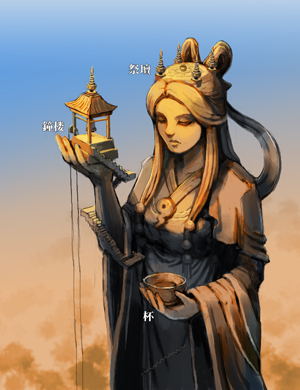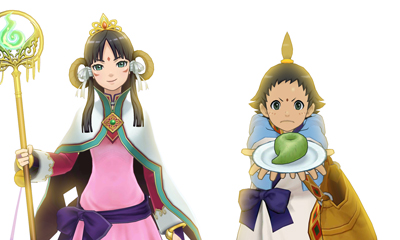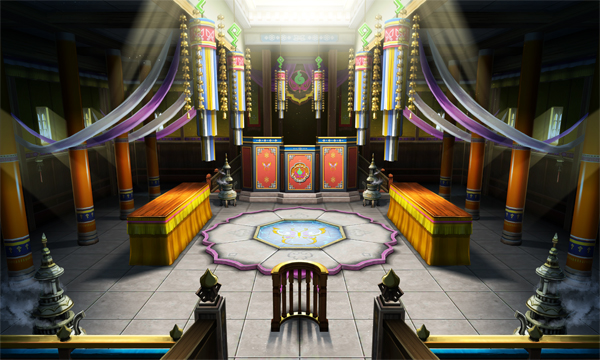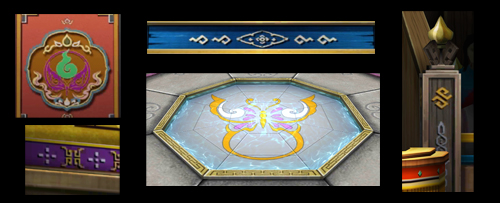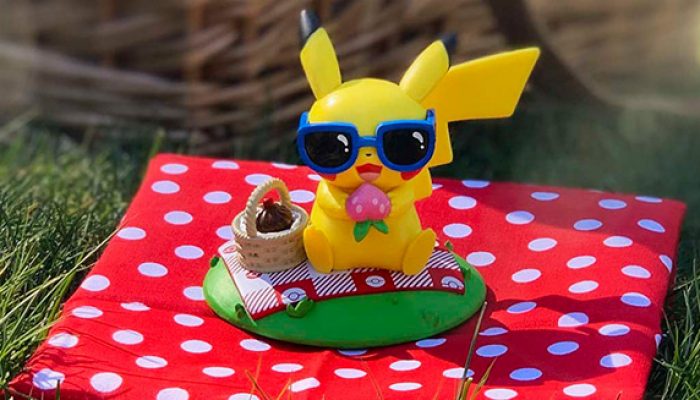 This is what Rayfa looked like in early drafts.
This is what Rayfa looked like in early drafts.
☆ NintendObs Weekly – Monday, August 15, 2016 – Sunday, August 21, 2016.
Journey to the West: The Search for the Kingdom of Khura’in
AUG 19
Hallo, hallo! This is Janet Hsu, localization director of Phoenix Wright: Ace Attorney – Spirit of Justice, back with another behind-the-scenes entry! Join me as the dev team and I journey towards finding the look and feel of the Kingdom of Khura’in. Are you ready? Because here we go!
When last time we met, Mr. Yamazaki and Mr. Fukuda talked about how they slowly made their way towards the game’s overall theme and plot. But they weren’t writing the game in a bubble of their own! No, sir! They had to work with all types of artists to figure out what this new, fictional country would look like and what kinds of people would inhabit it.
Picking up from Kellen’s excellent write-up of Rayfa, I’m happy to say that the art director and co-director of Spirit of Justice, Mr. Fuse, was kind enough to tell us a little about her rough-and-tumble, and very humble beginnings.
Rayfa’s Beginnings
Hello, I’m Takuro Fuse, art director of Ace Attorney: Spirit of Justice. I’m sad to say that I’ve been rather busy working on some art after the release of the Japanese version of the game, so I haven’t had the time to write much. However, I’d like to share a little with you today about how I went about designing Rayfa Padma Khura’in during the game’s development.
Around the time it was decided that there would be a sixth mainline game, but before we had decided on the theme of “courtroom revolution,” or even that the game would be set in a country called the Kingdom of Khura’in, we knew we wanted to include a teenage girl as a key character in this game. This is one of Rayfa’s initial designs back when we were toying with the idea of setting the game in an underground court – one that would deal with cases no normal court would dare take on because they involved the seedy underbelly of society.
Because the only thing we knew about her at the time was that she was going to be an Asian girl, there was nothing especially special or unique about her design. But we were thinking that we wanted her to be a shady character who liked to meddle in various affairs.
This initial design is something I pulled out of my drawer of ideas, so I feel like it’s rather easy to see my design aesthetics through it. The final version of Rayfa doesn’t really resemble this initial Rayfa… Although, now that I really think about it, I guess maybe she did serve as the model for Rayfa’s final design.
In time, once we decided to go with the theme of “courtroom revolution” and set the game in the Kingdom of Khura’in (a deeply religious country where the core tenants of its beliefs are rooted in spirit channeling), Rayfa’s character changed into that of a spiritually powerful priestess who was to dance a sacred dance during a special rite. Her design went through a number of drafts and revisions, and we tried out all sorts of different looks for her, but unfortunately, I’m going to have to leave it here for today…
Until we meet again, everyone!
Wait, that’s it?! *gasp!* Oh, don’t you worry, Mr. Fuse. I know where you sit. I will chase you down for more juicy stories later, you can be sure of that! Mwahahaha!
…*ahem*
I mean, thank you for taking time out of your incredibly busy schedule! I won’t be by again later to ask you more about character designs on the sly…
In the meantime, I’ll go and see what lead background artist Mr. Ishikawa is up to.
Far and Away in the Kingdom of Khura’in
Hi, everyone, I’m Takanori Ishikawa. On the heels of Ace Attorney: Dual Destinies, I’m back once again as the lead background artist on Spirit of Justice.
When I first heard we were making this game, a number of thoughts ran through my mind: “All I have to do is do what I did for Dual Destinies! With my experience and the in-game assets I created last time, this is going to be a cinch!” But just as I was thinking these things…
“Wait, what?! This game’s going to take place in a foreign country?! A spirit channeling-based country call the Kingdom of Khura’in…?!”
It would seem that Spirit of Justice was to take place in a foreign land, and it would seem that the many, many months of work it would take to create the look of such a mysterious country from scratch were waiting right there, just for me!
This new country is said to lie on the western edge of the Far East – a far, far, faraway land. And yet, the name “Khura’in” made me think of something really familiar. That’s right, it reminded me of everyone’s beloved Kurain Village. It would seem that Khura’in is connected to our Maya’s hometown of Kurain Village somehow.
So, exactly what kind of country is it, I wondered. Little by little, the team came to a consensus on a few key aspects of the kingdom.
- A scenic landscape featuring a chain of tall mountains and blue, clear skies
- A country with a unique culture that was developed as a result of how secluded they were due to the lay of the land
- A land where the art of spirit channeling still thrives today, to the point where they’re even using it to conduct trials in court
- And a place where a cute priestess performs a sacred dance
It sounded like a truly mystical country… I wondered if I could draw such a locale.
These are two of the initial pieces of concept art I drew.
Everything was so ginormous! I dare say these were more on the scale of something an ancient civilization would’ve built. But, while it may have looked cool, it apparently didn’t match up with what we had all agreed on. Honestly, though, I think it would’ve been fun if we could’ve had a big adventure in a place like this. Phoenix could’ve climbed up that giant stone statue, slipped past some traps in the ruins, fought with some people over the same ancient treasure… by which point, I guess this game would’ve become something out of a totally different genre.
I even created this wonderfully gigantic statue, but…
…sadly, it has been lost to the sands of time.
Aaaargh! It was so hard! Try as I might, I couldn’t figure out what kind of country the Kingdom of Khura’in should be. I kept on drawing and drawing, but the answer wouldn’t come to me.
“I don’t know… I really just don’t know…! Where the heck is this ‘Kingdom of Khura’in’ we’re looking for?!” I yelled inside my head.
And then, for some reason, I drew a courtroom that sits atop a pyramid-like structure… and then I drew yet another giant statue… You can tell just how lost I was by this point. But if you take a look at that white thing in the bottom right corner of that picture, you’ll see the beginnings of a “magatah’man” or “soul bun,” which appears in this game! Yup, it was around this time that the idea for those buns Ahlbi carries around with him was born.
As I was drawing this “soul bun,” I began to wonder, “Does this thing even taste good? What kind of people would make these? What kind of people would eat these? And what kind of face would they make when they do?” That’s when I realized I had forgotten to consider something important: the citizens of Khura’in!
I was so caught up in coming up with all these designs for this country that I’d completely lost sight of the most important thing of all – that of course I can’t create anything without knowing who was going to inhabit this landscape first. The truth had finally dawned on me.
It’s not me who creates the Kingdom of Khura’in; it’s the people of Khura’in who will create their own country.
A few months pass… and finally, the Hall of Justice is complete.
This is the courtroom that the Khura’inese people built.
In its solemn splendor, it looks more like a temple than a courtroom. Those intricate ornaments, the vibrant colors, all that incense-laden smoke, and there behind the judge’s bench is the sacred symbol of Khura’inism (the religion that is practiced throughout Khura’in), the mark of a butterfly that carries the souls of the dead to the Twilight Realm. It was a struggle to get to this point, but I think I managed to create a courtroom with a completely different feel from the one back home.
Even though this courtroom does have the usual benches and witness stand, I also created a space here for the Royal Priestess to perform her duties. That’s right, I’m talking about the Pool of Souls in the middle of the room. As the Royal Priestess, Rayfa usually stands in front of the pool during a trial, and as she performs the Divination Séance, she projects the final memories of the dead into it.
By the way, if you look really closely at the detailed ornamentation, you’ll see that a number of them feature flame-like shapes called “magatama” and Khura’inese butterflies. I hope you’ll look for these motifs throughout the game.
Just what kind of hard battles will be fought in this unusual courtroom? And what sort of truths will be revealed?! Sadly, I can’t tell you here, so you’ll just have to play to find out!
Thank you, Mr. Ishikawa! It really does sound like it was a lot of hard work! After all, you can’t conduct investigations in a new country without locales to visit, and that courtroom looks spectacular.
Actually, if you’ve never seen the inside of a Buddhist temple, they do look an awful lot like that Khura’inese courtroom in certain regards. Different sects across different Asian countries have slightly different looks, but there are definitely some common traits they all share, which make this courtroom feel new and unique, yet strangely familiar to someone like me.
Speaking of someone like me, I guess now would be a good time for me to share just how the look of the Khura’inese language came about in the English version.
Khura’in vs. Kurain: Bringing the Khura’inese Language to Life
Much like everyone else on the team, my first thought upon hearing that the game was going to take place in a foreign country was, “Uh… So I have to come up with how to represent this new country’s language in Roman letters???” But I quickly got over my shock as it dawned on me that my language nerd skills were finally going to be of some use! Because, you see, there’s a whole discipline in the field of linguistics devoted to how to Romanize languages that don’t use Roman script (or what we English speakers call the alphabet) in a process called Romanization.
But why was I all nervous in the first place, you may ask. Why didn’t I just simply Romanize the Japanese source text and call it a day? Well, if I did that, then the Khura’inese language would really be little more than a Romanization of the Japanese language, and I couldn’t do that! Just as the designers had created a visual look for each letter of the Khura’inese alphabet and even some single-character words like Prosecutor Nahyuta Sahdmadhi’s interjection “Satorha!”, I knew that Khura’inese had to have a distinct linguistic look and identity of its own.
Is the mean ol’ prosecutor picking on you again with a word you don’t know? Welcome to Phoenix’s world.
The dev team drew their inspiration from a number of Asian cultures in designing the look and culture of Khura’in, which is exactly what my team and I did as well in designing the look of Romanized Khura’inese. Being a Taiwanese-American with 2.5 languages under my belt (Mandarin Chinese listening and reading = passable at best, my kindergartener-level speaking and writing skills = brings nothing but great shame on my ancestors) and a medium level of familiarity with East Asian religions and culture, I had a rough idea going in of how Khura’inese might eventually look.
The Kingdom of Khura’in is situated somewhere on the western edge of the Far East. Combined with the many tall mountains you often see in the backgrounds, this effectively places the small country somewhere in the purple zone below.
It’s a little like playing “Where in the World is Khura’in?”
In our real world, there are hundreds of languages and dialects in that purple region alone, but narrowing it down to the most prominent languages and dialects, including Tibetan, Nepali, Hindi, Pashto, and Urdu, reveals commonalities in how the writing systems of that region are Romanized.
Without getting into too many details (oh, I’ll go into full-on Linguistics Ema mode in a few paragraphs, trust me), at a glance, it looks like there are a lot of h’s and apostrophes used in the Romanization of these languages. But just knowing what they looked like wasn’t enough for me. All those h’s and apostrophes weren’t there just to look pretty, that’s for sure; they’re tied to how those words are pronounced. So what I needed to do next was to mesh how Romanized Khura’inese would look with pronunciations provided by the original Japanese source text. This is where the distinction between the real Khura’inese pronunciation and the Japanized and Anglicized pronunciations of Khura’inese words come into play.
Wait, what “real pronunciation,” you might ask. Well, let’s consider a real-life example.
Take one Mr. Johann Sebastian Bach – classical composer of German origins. It’s pretty easy for an English speaker to pronounce his name, and for the most part, they’d come pretty close to how a native German speaker would pronounce Mr. Bach’s name because we have similar sounds in the English language (English and German being relatives of each other linguistically). But for a Japanese speaker, they will never be able to accurately replicate the sounds for “Bach” if they are using the Japanese syllabary. That’s because that final “ch” sound simply does not exist in the Japanese language. Instead, they must render the name Bach according to their rules like this:
Bach ⇒ バッハ (bahha)
Sounds more like a laugh than his actual name, doesn’t it?
Now, going in the other direction, how well can a Romanization system really represent the sounds of a language like Chinese or Japanese? In the case of Chinese, rendering the word for “small” (小) as “xiăo” doesn’t even come close to looking like its actual pronunciation. But using “shăo” wasn’t an option since there is another, very similar sound that’s already monopolizing the “sh” Romanization, making shăo (少) a totally different word that means “less”! (Ironically, that one is pronounced more like “shr”…) So yeah… Roman letters are not so great at representing a language like Chinese.
As for Japanese, it’s also kinda terrible too, in some instances. Take for example, everyone’s favorite letters, らりるれろ. Are these “ra, ri, ru, re, ro” or “la, li, lu, le, lo”? You often see words like “ramen” spelled with the letter “r,” but when you listen to a native, the sound is best described as a “dla” where it’s a strong “l” sound said with your tongue touching the top of your mouth like you’re saying “d” instead.
Romanization can also fail when it doesn’t tell the reader how to parse a word correctly. Take the name “Junichi.” Is his name really pronounced as “ju-n-i-chi” or is it “ju-ni-chi”? At least for this problem, there is a solution: we can use an apostrophe to show what the original Japanese intended. In this case, the former parsing could be Romanized as “Jun’ichi” for clarity.
I think astute linguists among you are beginning to see how all of the puzzle pieces are coming together, so let’s return to my original dilemma: How do I mesh the pronunciation of Khura’inese words as provided by the Japanese source text with the Romanized text aesthetic I’ve devised for the Khura’inese language? Let’s take the word “Khura’in” itself as an example, shall we?
Japanized spelling: クライン (Japanese Romanization: kurain, pronounced: “koo – dla – een”)
Romanized Khura’inese spelling: Khura’in (pronounced: “khoo – RA – een”)
As you can see, the apostrophe is there in order to bring out the separation of the last two syllables so that the pronunciation remains as similar as possible to the Japanese, and (hopefully) prevents them from getting mashed into one syllable that sounds like the English word “rain.” But that’s not its only function in Khura’inese – the apostrophe can also denote a glottal stop, which slightly affects the pronunciation with a small, voiceless “hiccup” as it were.
As you can see, in the case of “Khura’in” and some of the other Khura’inese words you’ll come across in this game, I did take a few liberties when adapting the Japanese into the Romanized Khura’inese. Sometimes, I imagined a longer vowel sound that doesn’t exist in Japanese to exist in the original Khura’inese, like a longer “ah” sound or a “short i” sound like in the word “kin,” which is not perfectly replicable in Japanese (it comes out sounding more like “keen” in Japanese). These adaptations are similar to the Bach example, where I’m trying to “deduce and extract” the original “real” Khura’inese pronunciation from the Japanized spelling.
But don’t worry! At least Khura’inese looks like how it sounds, unlike Tibetan…
As for words that were originally meant to be puns in the Japanese source text? Well… you’ll just have to see what sorts of puns they’ve been adapted into for yourself next week when the demo is released on August 25th!
Yes, you heard that right. The demo can be yours NEXT WEEK!
You know what else can also be yours next week? Another trip with me through the development of Spirit of Justice! Next Friday, we’ll explore the creation and localization of the user interface, or “UI,” and the magical visual effects that were used to add that extra layer of mystery to the land of spirit mediums and channeling.
Until then!
Catch up on previous blog entries here!
— Janet Hsu at Capcom
Source: Capcom Unity.
At NintendObserver, the comments are on Discord.
Click on Community to learn more. 🙂
…
…Wanna play? Buy a 3DS.
And if you’ve already got yours, click on Phoenix Wright Ace Attorney Spirit of Justice for everything you need to know about the game. 😀
